Yunnan Tourism: Tour Haigeng Park and Guandian Ethnic Village (Photo)
Haigeng Park (Photo: Feng Ganyong)
At 8:30 a.m. on March 13, 2023, the reporter took a taxi from the hotel where he stayed to Haigeng Park located on the bank of Dianchi Lake for sightseeing. After about half an hour's drive, I successfully arrived at my destination.
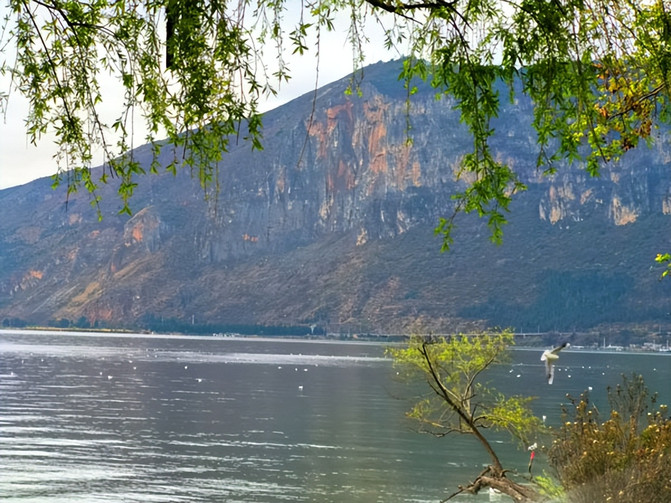
Looking at the Western Mountains from the bank of Dianchi Lake (Photo: Feng Ganyong)
Only then did I realize that Haigeng Park is an open garden with a 2.5-kilometer-long water coastline along the bank of Dianchi Lake. After passing through the memorial stone in Haigeng Park, you reach the vast bank of Dianchi Lake.
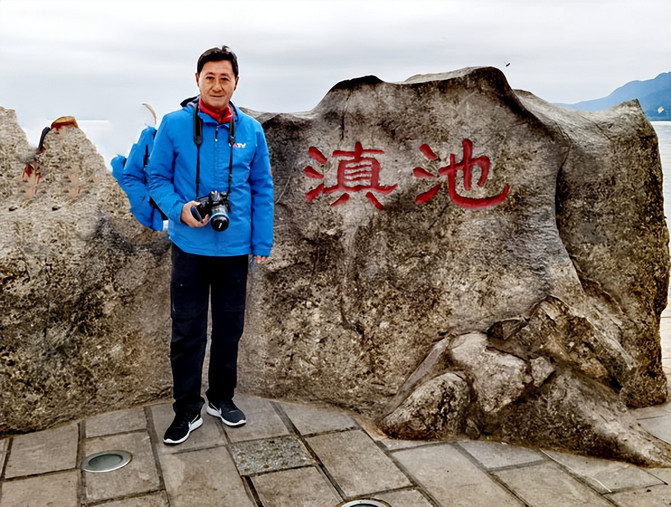
Photo taken in Dianchi Lake (Photo: Wang Jue)
I saw tourists playing everywhere along the Dianchi Lake. The first impression it gives people is definitely a good place for people to relax and vacation. Because the area of Haigeng Park along the bank of Dianchi Lake is too long, the reporter only wandered between the two docks for a short period, but he photographed a lot of beautiful scenery of Dianchi Lake.

People and birds celebrate together on the bank of Dianchi Lake (Photo: Feng Ganyong)
In Haigeng Park, you can see painting pavilions, stone boats, sea-viewing corridors, lush lawns, gorgeous cherry blossoms, luxury yachts, seaside leisure squares, and tens of millions of seagulls flying in winter and spring to feed and communicate with people. The scene all makes people feel that this place is full of natural harmony and romance.

Live broadcast scene on the bank of Dianchi Lake (Photo: Feng Ganyong)
On the bank of Dianchi Lake, I saw more than a dozen young and middle-aged people, dancing and dancing for live broadcasts. Everyone in different shapes and shapes fully performs their ultimate performance in front of the mobile phone camera... It's quite interesting.

Watching seagulls soar in Haigeng Park (Photo: Feng Ganyong)
The sea ridge, as the name suggests, is the ridge across the sea. It was originally a wedge-shaped long embankment inserted across the Dianchi Lake from east to west. Starting from Haigeng Village in the east and ending at the foot of the West Mountain in the west, it has a total length of 5 kilometers and a width of 60 to 300 meters. It divides more than 300 square kilometers of Dianchi Lake into two; to the south of the ridge is the vast Dianchi Lake, and to the north of the ridge is the "Caohai".

Dianchi Waterside Wharf (Photo: Feng Ganyong)
Built in the early 1960s, this park is about 200 meters wide from north to south and covers an area of 750 acres. The water echoes scenic spots such as Xishan Mountain and Daguanlou, becoming an integrated tourist area. The embankment is about four and a half kilometers long, and the width ranges from 40 to 50 meters to 200 meters.

Cycling styling (Photo: Feng Ganyong)
Entering Haigeng Park, the reporter saw a bicycle riding on the bank of Dianchi Lake, which reminded the reporter of November 10, 2017, when he participated in the "2017 China Bicycle League Yunnan Kunming Finals and Kunming Round-Dianchi Plateau Bicycle Invitational Tournament". A good time.

Looking back at the time of collecting styles (Photo: Feng Ganyong)
In Haigeng Park, people will enjoy two beautiful scenery. One is two century-old eucalyptus trees connected by branches. One is tall and straight, and the other is graceful, like a loyal couple, looking at Dianchi Lake hand in hand. And the other Sleeping Beauty Mountain can only truly see the appearance of the Sleeping Beauty Mountain when you reach the sea ridge. Her face is clear, her curves are graceful, and her hair is flowing, forming a magnificent picture with the sunset. The scenery in the four seasons is different, beautiful and harmonious.
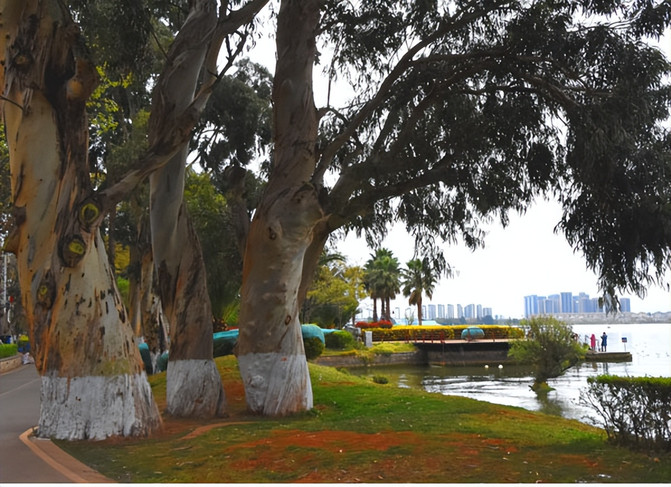
Landscape of large trees by the water (Photo: Feng Ganyong)
The Dianchi Lake nestled in Haigeng Park was called the "sea" by the ancients. Today, the ten-mile long embankment is lined with trees, and the speeding fast boats splash snow-white waves. The blue sky, the deep blue sea, the green grassland, and the fresh air shows people the seaside style unique to the sea. Only when people arrive here can they deeply feel what the artistic conception of "the sky is high and the clouds are clear, the sea is broad and the chest is wide".

Photo taken in Yunnan Ethnic Village (Photo: Feng Ganyong)
At 9:40 that day, after finishing sightseeing in Haigeng Park, the reporter continued to take a taxi and headed for Daguanlou. On the way, he suddenly saw the Grand Archway of Yunnan Minzu Village. Since the reporter had filmed the special film "Chinese National Sports" in Yunnan from 11.1 to 12.16 in the last century, he had a lot of affection for the ethnic minorities in Yunnan. Therefore, the reporter temporarily changed the second stop where he wanted to go to Daguanlou on the day of his trip to Yunnan to a visit to Yunnan Minzu Village.

Walking into the ethnic village (Photo: Feng Ganyong)
Walking into the 89-acre Yunnan Ethnic Village Scenic Area and sighing that it is so big. Fortunately, there are sightseeing battery cars for people to use in the scenic area. After thinking about it, it was more convenient to stroll for sightseeing and taking photos, so the reporter and his party began to stroll around the ethnic village.
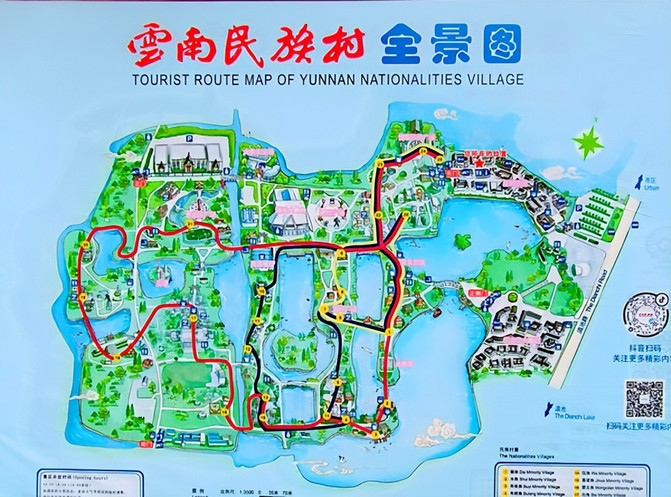
Panorama of the ethnic village (Photo: Feng Ganyong)
I saw that the ethnic village was intertwined with water and land, fresh and elegant, and the scenic spots of each village were scattered. There are green shaded paths, pavilions, corridors, and arch bridge stone steps. Especially when I saw some familiar scenes in ethnic villages that I had seen before, I felt very cordial.

Photography of national sports that year (Photo: Guo Gang)
I remember that during our one-and-a-half shooting experience from southeastern Yunnan to northwest Yunnan, we successively photographed 11 ethnic minority sports including Hani, Lahu, Dai, Wa, Naxi, Nu, Lisu, Jingpo, De 'ang, Yao, and Miao. Nowadays, I still remember it in the ethnic village.
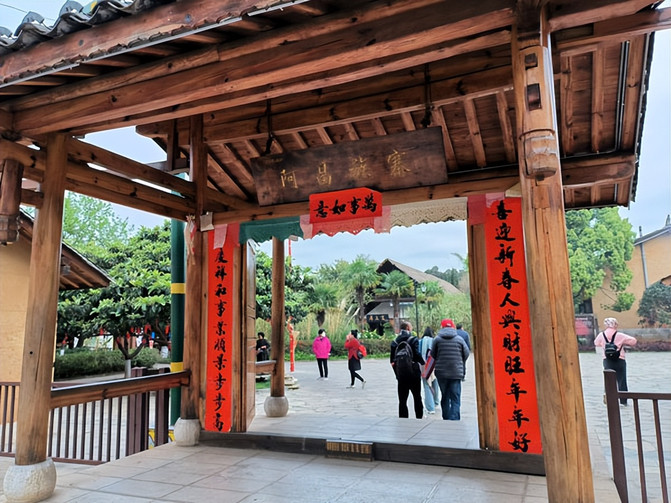
Walking into the Achang Village (Photo: Feng Ganyong)
The reporter came in from the east gate of the scenic area and first visited the Achang Village. After that, I visited Jingpo, De 'ang, National Musical Instrument Square, Nu, Musical Instrument Shop, Dulong, Pumi, Dai, National Fruit Shop, Shui, Duoyihe Embroidery Shop, Buyi, Bulang, Ghost and Ghost Square, Wa, Sigangli, Miao, Dujietai, Yao, Hui, Manchu, Jinuo and many other ethnic villages and attractions. Although one hour and forty minutes of viewing failed to visit all the attractions in the Minzu Village, I was still very satisfied.

Rehearsing dance (Photography: Feng Ganyong)
The Achang Village is mainly composed of a college building, echoing buildings such as the gate of the village, handicraft workshop and other buildings. It is quite distinctive with blue tiles and brick walls, stone foundations and pillars. Walking into the courtyard, I saw two young men from the Achang ethnic group rehearsing national dances. Each move is in place.

Jingpo Square (Photo: Feng Ganyong)
Not far from the Achang compound is Jingpo Village, which covers an area of 15 acres in Yunnan Ethnic Village. It has spacious and generous residential buildings and exquisite and gorgeous "Shanguan Houses". The architectural form embodies the structural characteristics and layout shapes of the Jingpo people such as "Ganlan Style" and "Inverted T-Style".

The Mu Nao vertical song filmed that year (Photo: Feng Ganyong)
In particular, seeing the "Mu Nao Zong Ge Display Building" erected in the center of the square reminded reporters of the scene of filming Mu Nao Zong Ge in the Jingpo Village of Sadin Village, Longchuan. The patterns and sculptures of Mu Nao Zongge Shidong symbolize the Jingpo people's will to unite and move forward and their brave and resolute character. The Jingpo people believe in the primitive religion that all things have a spirit, believe in ghosts and gods, and worship their ancestors.
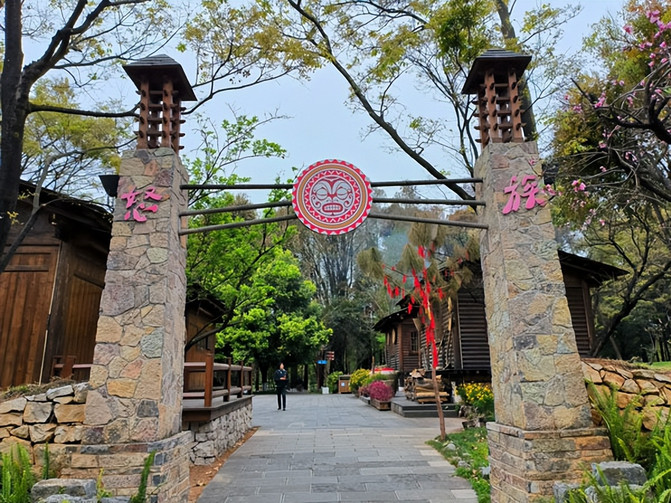
Nu Village (Photo: Feng Ganyong)
Arriving at Nu Village, the main body is typical prefabricated houses with stone sheets and tile-roofed houses. Some halls are accessible, or suites are connected with tiles, and terraces and stone steps are calmly decorated, which fully demonstrates the vivid spatial composition of Nu buildings and creates a combination of humanities and nature. In Nu Village, reporters were reminded of the happy time when filming Nu and Lisu on the bank of the Fugong Nujiang River.

Corner of the Dulong Village (Photo: Feng Ganyong)
After leaving Nu Village, we came to Dulong Village, which consisted of a typical prefabricated house and wooden houses. The mother and son moved in, showing a real picture of people asking about fireworks. At the same time, a tree-dwelling building was built, so a historical mark was found.

Pumi Village (Photo: Feng Ganyong)
Arriving at the Pumi Village, it is mainly composed of a typical plank house system of "battering wood" double-layer residential houses, which is enclosed in a folk way. Surima wine is brewed according to local methods with barley as the main material. It has always been known as "local beer". The west end building creates the style of Surima's "workshop".

Corner of the Dai village (Photo: Feng Ganyong)
Walking out of Pumi Village and passing through a bridge is the Dai Village. It covers an area of 27 acres and is surrounded by water on three sides and shaded by green trees. The "Ganlan-style" Dai bamboo buildings are connected to the solemn Burmese Temple through winding red gravel paths. The majestic white pagoda, the exquisite wind and rain bridge, as well as the wind and rain pavilion, water well, bell pavilion and other buildings are full of the strong customs of the Dai family and are the true folk landscape of the Dai village.

Aquarium House (Photo: Feng Ganyong)
From the Dai Village to the Shui Village built along the water, it is surrounded by farm tools and is mainly composed of the representative prefabricated houses of the "street-face house" style buildings in Gugan Shui Township, Fuyuan County, Yunnan Province, as well as the Eight Diagrams Wheel, Longtan, Dalongshu and other landscapes, expressing the ancestral style and characteristics of Shui culture. However, the reporter's filming of Shui nationality was not carried out in Yunnan, but in Sanshui, Guizhou.

Buyi Village (Photo: Feng Ganyong)
Arriving at the Buyi stockade, which is still built by the water, this is a way of building the two houses loyal to the people, achieving the perfect combination of the Qionglong system and the Banwu system. The water pavilions and corridors in the village lead to the secluded scenery. It is not only a condensation of the folk customs, but also a new creation of the garden landscape, which is quite representative. Buyi, like the Shui people, was also photographed by reporters in Wudang, Guizhou instead of Yunnan.

Wood drum houses in Wa Village (Photo: Feng Ganyong)
Continue walking from the Shui Village to the Wa Village located in the southeast corner of "Cuiyi Zhou". I saw that there were ganlan-style buildings with thatched roofs, Niutou Square, Shenling Square, Sigangli stone carvings and granaries in the village.

The Wa wooden drum dance photographed that year (Photo: Feng Ganyong)
The Wa people were the first ethnic group photographed when reporters came to Yunnan, so they were deeply impressed. In the Wa village of Ximeng that year, reporters photographed many Wa folk sports events such as "Wood Drum Dance","Ox Rape Dance","Stomping Dance", and "Chongming Rice Dance".

The Wa people took work photos back then (Photo: Hu Xiaofei)
Walking into the Wa Village, some scenes on Niutou Square in the Wa Village are familiar. This is an ancient cattle raiding activity venue for the Wa people. The horns in the middle of the field are the Wa people's stockade piles. The two stone figures in front of the square are the Wa people's male and female ancestors.

Si Gangli (Photo: Feng Ganyong)
Shenling Square expresses the Wa people's natural worship concept that all things have spirits and souls are immortal. The two stone statues in the field are "Mu Yiji" and "Ayi 'e", which the Wa people most admire. At this time, a Wa youth was performing a show in the village, attracting many tourists to watch it.

Bulang Village (Photo: Feng Ganyong)
Bulang Village and Wa Village are adjacent to each other, and there are residential buildings, ghost and god squares and other buildings built in the village. Ghost and God Square expresses the nature worship view of the Bulang people that all things are spiritual. The totem of the Bulang people is erected in the center of the square. At the same time, the square is also an important place for the Bulang people to worship gods, perform songs and dances, and hold traditional folk activities.

Miao Village (Photo: Feng Ganyong)
The Miao village in the ethnic village selects mountainous areas as the environment, which is quite representative; it uses typical prefabricated houses such as "hanging buildings" as the main body, refining the essence of Miao architecture. The hanging foot building displays Miao costumes and handmade craftsmanship, while the residential building reflects the style of daily life. Back then, reporters photographed the Miao people in Miao Village, Tangzibian Village, Zhuili Street Township, Wenshan.

Yao Village (Photo: Feng Ganyong)
Arriving at the Yao stockade in the ethnic village, it consists of residential buildings such as Diaojiao towers, bungalows, rural Taoist temples, granaries, and stockade gates. The infiltration of some Taoist cultural elements is quite typical. Looking back at that time, the Yao people were photographed in Yaozhai Village, Chapingba, Hekou. The scene here vaguely reminded reporters of some vague impressions of Yaozhai at that time.

Hui Village (Photo: Feng Ganyong)
The Hui villages in the Ethnic Village Scenic Area are mainly composed of residential buildings, mosques and blocks, dotted with gardening and gardening scenery, which more fully expresses the layout style and construction characteristics of the Hui buildings in Yunnan.

Photo taken by the Manchu Academy (Photo: Feng Ganyong)
The Manchu courtyard in the ethnic village draws on the construction method of the Manchu residential compound in Benxi, Northeast China, and injects a large number of elements from the Kunming courtyard building. Therefore, it is a perfect combination of residential buildings in the two places.
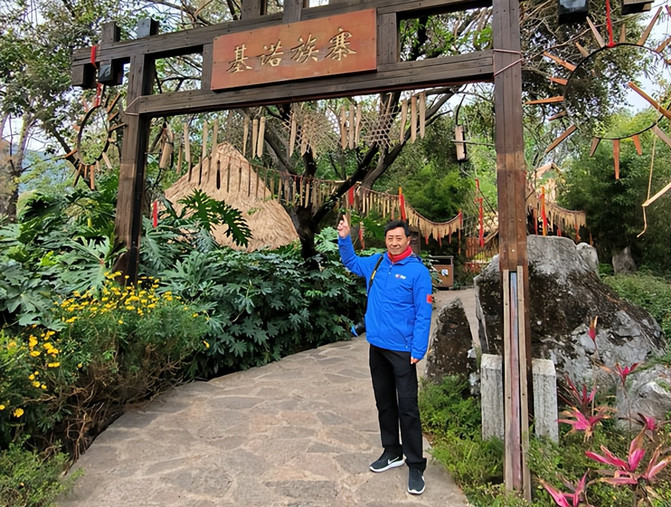
Photo taken in Jinuo Village (Photo: Wang Jue)
Finally, we came to the Jinuo Village in the village, which was connected to the Wa Village and Bulang Village by a bridge and faced each other across the water. Walking into the Jino Village, you can see green trees and flowers dotted with jagged rocks, and Jino thatched houses are scattered, as if you are walking into the rolling mountains of Jino Mountains. The Jino Village has large public houses, residential buildings, granaries and Sun Square for the Jino people.

De 'ang Buddhist Temple (Photo: Feng Ganyong)
Since its completion and opening in February 1992, Yunnan Ethnic Village has displayed the architectural art, song and dance costumes, cultural customs, religious beliefs and living customs of various ethnic groups in Yunnan in a vivid and vivid form. Let reporters also see things here and experience feelings, and spend a beautiful time in which realistic viewing and recalling the past complement each other. It really benefited the reporter a lot and had endless aftershocks...

Scenery of Yunnan Ethnic Village (Photo: Feng Ganyong)
2023.03.13 With the successful conclusion of the reporter's visit to the Yunnan Ethnic Village, the 11-day trip to Yunnan finally came to an end. At 16:38 pm that day, the reporter and his party returned to Beijing on Xiangpeng Airlines Flight 8L9987, a subsidiary of Hainan Airlines. Arrive at Capital Airport Terminal T2 at 20:10 after a four-hour flight.

Aerial view of Yunnan (Photo: Wang Jue)
When the plane flew into the blue sky, the reporter looked out of the window and looked at the beautiful scenery of Yunnan. He was really fascinated, and he couldn't leave it alone, and he had endless aftershocks... Goodbye Yunnan! I will come again if I have the opportunity. (Photo and text: Feng Ganyong)
(Source: China News Network)
Previous Article:First sight of the terraces in the distant mountains
Next Article:Illustration Yunnan| It's an endless journey in the inner world
